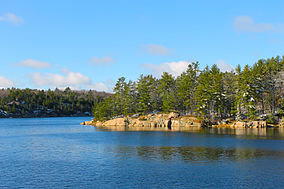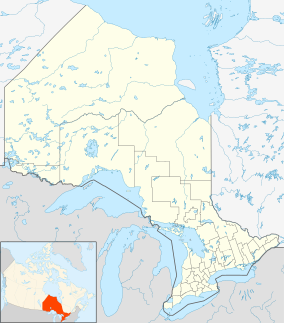Killarney Provincial Park
| Killarney Provincial Park | |
|---|---|
|
IUCN category II (national park)
|
|

Early November at George Lake, Killarney Provincial Park
|
|
| Nearest city | Sudbury, Ontario |
| Coordinates | 46°05′N 81°20′W / 46.083°N 81.333°WCoordinates: 46°05′N 81°20′W / 46.083°N 81.333°W |
| Area | 485 km2 (187 sq mi) |
| Established | 1964 |
| Governing body | Ontario Parks |
Killarney Provincial Park is a provincial park in central Ontario, Canada.
Although not as well known as the world famous Algonquin Provincial Park, Killarney is one of Ontario's most popular wilderness destinations. With its sapphire blue lakes and white quartzite ridges it is considered one of the crown jewels of the Ontario Park system.
The park contains just one campground at the George Lake entrance as it is primarily a wilderness park. There are few facilities to allow visitors a chance to experience the solitude and beauty of its undisturbed natural setting. It boasts spectacular hiking trails and canoe-in back-country camping. The canoe routes include well maintained portages between lakes. The campground includes six heated yurts which have electric lighting, a power outlet, a propane barbecue and bunk beds.
Situated on the north shore of Georgian Bay in the municipality of Killarney, the park straddles the La Cloche range, large rounded white quartzite hills that dominate the landscape. The white peaks and cliffs contrast with the pine and hardwood forests and the boggy lowlands that surround the park's many lakes.
Quartzite is weather-resistant and contains few nutrient-bearing minerals. Soils, where present, tend to be shallow and infertile. Very stony sandy loam is the most common soil texture reported. Podzol profile development is usual in well-drained situations. Mineral-rich rock types such as diabase and limestone occur locally and the soils that have developed over them support some of the park's more luxuriant vegetation.
The park lies within the Eastern forest-boreal transition ecoregion, so there is a wide variety of plant life. The park is home to moose, deer, black bears, wolves, bobcats, martens, and beavers along with over 20 species of reptiles and amphibians. Over 100 species of birds breed, nest or rest within park boundaries.
...
Wikipedia

